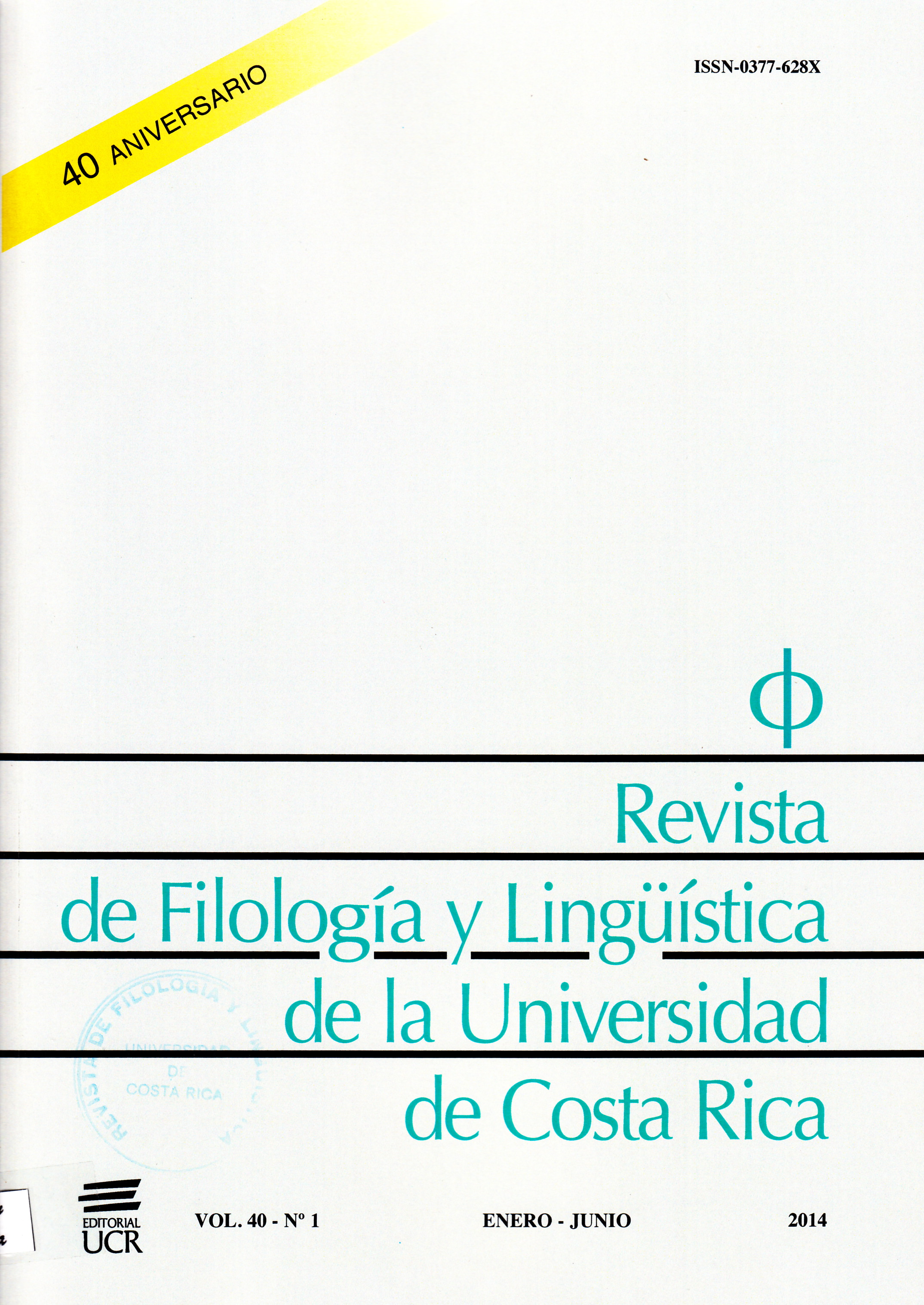Abstract
This study reports on the trends in children’s use of taps by 15 Costa Rican Spanish-speaking monolingual children between ages 3;0 and 5;6. Data were obtained through audio-recordings of the children’s naturalistic speech, yielding 1080 target-words. 80% of the taps were correct, but the remaining 20% evidenced either omissions of the tap (14%) or substitution of the tap for [l], [n], [t], [d], [j], [tS], [D], or for a voiceless assibilated rhotic. A main finding in this study was the consistent omission of the tap in infinitive verb forms before a consonant initial enclitic pronoun. This omission type is interesting in that it appears to be directly related to the complexity involved in nominal enclitics, as children do not always omit the tap in similar phonetic contexts (i.e., /Cr/ clusters). Although this last pattern has been reported for adult Costa Rican Spanish, it has never been reported in child speech.
References
Acevedo, M.A. (1993). Development of Spanish Consonants in Preschool Children. Journal of Childhood Communication Disorders. 15 (2), 9-15.
Anderson, R.T. & Smith, B.L. (1987). Phonological development of two-year old monolingual Puerto Rican Spanish-speaking children. Journal of Child Language. 14 (1), 57-78.
Bosh-Galcerán, L. (1983). El Desarrollo Fonológico Infantil: Una prueba para su evaluación. Anuario de psicología. 28 (1), 85-114.
Bradley, T.G. (1998). Assibilation in Ecuadorian Spanish. In J.M. Authier, B.E. Bullock & L.A. Reed (Eds.). Formal Perspectives on Romance Linguistics. Selected papers from the 28th Linguistic Symposium on Romance Languages. (57-71). University Park.
Bradley, T.G. (2001). A typology of rhotic duration contrast and neutralization. By M.J. Kim and U. Strauss (Eds.) Proceedings of the 31st North East Linguistics Society. (79-97). Amherst, MA: GSLA Publications.
Bradley, T.G. (2005). Systemic markedness and phonetic detail in phonology. In R. Gess & E. Rubin (Eds.). Experimental and theoretical approaches to Romance linguistics. (41- 62). Amsterdam: John Benjamins.
Bradley, T.G. & Schmeiser, B. (2003). On the phonetic reality of Spanish // in complex onsets. University of California: Working draft.
Calvo-Shadid, A. & Portilla-Chaves, M. (1998). Variantes retroflejas de /r/ y /r/ en el habla culta de San José. Revista Káñina. 22 (1), 81-86.
Ciccia-Gabillo, C., Montezuma del Castillo, O., Elías-Ulloa, J., Gabillo-Ciccia, G., Echenique- Herrera, M., Raffo-Castro, G. & Seminario-Otórtoga, A. (2006). Las divergencias fonológicas entre el habla adulta el de los niños en el español hablado en Lima (Perú). Revista de Logopedia, Foniatría y Audiología. 26 (4), 215-230.
Domínguez, L. (2003). Interpreting reference in early acquisition of Spanish clitics. In S. Montrul & F. Ordóñez (Eds.). Linguistic Theory and Language Development in
Hispanic Languages, Papers from the 5th Hispanic Linguistics Symposium and the 4th Conference on the Acquisition of Spanish and Portuguese. (212-228). University of Illinois.
Fernández-Aragón, A., Gutiérrez-Coto, L., Morgan-Mora, G., Romero-Zúñiga, I.L. & Zawaski- Wisniewiski, S. (1994). Problemas en la la adquisición de la lengua maternal:
fonética y fonología. (Tesis de Licenciatura sin publicar). Universidad de Costa Rica.
Fujino, H., & Sano, T. (2002). Aspects of the null object phenomenon in child Spanish. In A.T. Pérez-Leroux & J.M. Liceras (Eds.). The acquisition of Spanish Morphosyntax. (67-
. Dordrecht: Kluwer Academic Publishers.
Gildersleeve-Newman, C.E., Kester, E.S, Davis, B.L. & Peña, E.D. (2008). English speech sound development in preschool-aged children from bilingual English-Spanish environments. Language, Speech, and Hearing Services in schools. 39 (3), 314-328.
Goldstein, B & Iglesias, A. (1996). Phonological Patterns in Puerto Rican Spanish-speaking children with phonological disorders. Journal of Communication Disorders. 29 (5),
-387.
Gómez-Fernández, D. (2004). La adquisición de las líquidas en los niños de Sevilla y su provincia: Desde los doce a los treinta y seis meses. Revista de Filología y su Didáctica. (27), 125-185.
Grinstead, J. (2004). Subjects and interface delay in child Spanish and Catalan. Language. 80 (1), 40-72.
Gutiérrez-Clellen, V.F. & Simon-Cerejido, G. (2007). The discriminant accuracy of a grammatical measure with Latino English-speaking children. Journal of Speech, Language, and Hearing Research. 50 (4), 968-981.
Harris, J. (1969). Spanish Phonology. Cambrigde: Massachusetts.
Jiménez, B.C. (1987). Acquisition of Spanish consonants in children aged 3-5 years, 7 months. Language, Speech, and Hearing Services in Schools. 18, 357-363.
Ladefoged, P. (1971). Preliminaries to Linguistic Phonetics. London & Chicago: University of Chicago Press.
Ladefoged, P. (2001). Vowels and Consonants: An introduction to the sounds of languages. Oxford: Blackwell Publishers.
Ladefoged, P. & Maddieson, I. (1996). The Sounds of the World’s Languages. Oxford: Blackwell.
López-Morales, H. (1992). La investigación dialectal sincrónica en Hispanoamérica: presente y futuro. Actas del Congreso de Lengua Española. Sevilla, Instituto Cervantes. (767-787).
López-Ornat, S. (1994). La Adquisición de la Lengua Española. Madrid: Siglo XXI.
Mason, M., Smith, M. & Hinshaw, M. (1976). Medida Española de articulación [Measurement of Spanish Articulation]. San Ysidro, CA: San Ysidro School District.
Moralejo, R. (2007). Adquisiciones fonético-fonológicas en niños de 4 años de edad. http:// www.espaciologopedico.com/ [Available June, 2010].
Müller. N. & Hulk, A. (2001). Crosslinguistic Influence in Bilingual Language Acquisition: Italian and French as Recipient Languages. Bilingualism: Language and Cognition.
(1), 1-21.
Proctor, M.I. (2009). Gestural characterization of a phonological class: The liquids. (Unpublished Doctoral Dissertation). Yale University.
Quilis, A. (1999). Tratado de Fonología y Fonética Españolas. Madrid: Editorial Gredos.
Recasens, D. (1991). On the production characteristics of apicoalveolar taps and trills. Journal of Phonetics. 19, 267-280.
Sánchez-Corrales, V. (1986). Escisión fonológica de /®/ en el español de Costa Rica. Revista de Filología y Lingüística. 12 (2), 129-133.
Stockwell, R.P. & Bowen, J.D. (1965). The Sounds of English and Spanish. London & Chicago: University of Chicago Press.
Torrens, V. & Wexler, K. (1996). Clitic Doubling in early Spanish. In Proceedings of 20th the Boston University Conference on Child Language Development. (780-791).
Sommerville MA: Cascadilla Press.
Umaña-Aguilar, J. (1981). Variable vibrants in middle-class Costa Rican Spanish. (Unpublished Masters Thesis). Georgetown University.
Vásquez-Carranza, L.M. (2006). On the phonetic realization and distribution of Costa Rican rhotics. Revista de Filología y Lingüística. 32 (2), 231-309.
Willis, E.W. 2006. Trill Variation in Dominican Spanish: An Acoustic Examination and Comparative Analysis. By N. Sagarra & A.J. Toribio (Eds.) Selected Proceedings of the 9th Hispanic Linguistics Symposium. (121-131). Sommerville: Cascadilla Proceedings Project.

